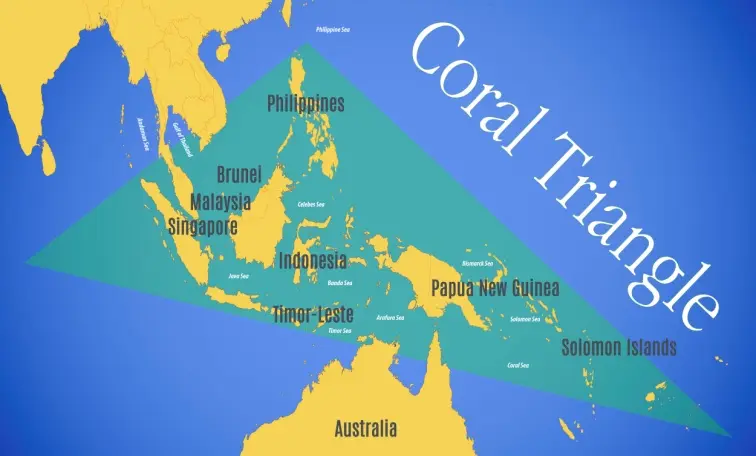Introduction
- Coral reefs are among the most diverse and valuable ecosystems on the planet, providing habitats for a vast array of marine life and offering numerous benefits to humans. However, these delicate ecosystems face a myriad of threats that endanger their existence. Understanding the types, formation, threats, and significance of coral reefs is crucial for their conservation and preservation.
What are Corals?
- Corals are marine invertebrates (animals not possessing a spine) belonging to a large group of colourful animals called Cnidaria.
- All Cnidarians share the same distinguishing characteristics; a simple stomach with a single mouth opening surrounded by stinging tentacles.
- Other animals in this group include jelly fish and sea anemones.
- Each individual coral animal is called a polyp, and most live in groups of hundreds to thousands of genetically identical polyps that form a ‘colony’.
- The colony is formed by a process called budding, which is where the original polyp literally grows copies of itself.
- A baby coral looks like a little tiny jellyfish and floats around near the surface at first, and then in the water column until it finds a hard surface to attach to.
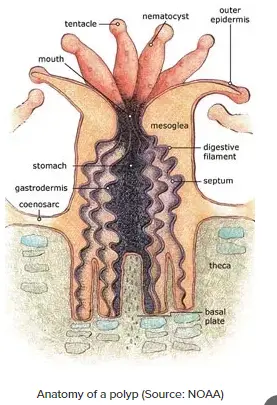
What are Coral Reefs?
- Hard corals extract abundant calcium from surrounding seawater and use this to create a hardened structure for protection and growth.
- Coral reefs are therefore created by millions of tiny polyps forming large calcium carbonate structures.
- Coral reefs are the largest living structure on the planet, and the only living structure to be visible from space.
What is the Difference Between Hard and Soft Coral?
a) Hard Corals
- Hard corals produce a rigid skeleton made of calcium carbonate (CaCO3) and are the primary reef-building corals.
- Hard coral colonies consist of hundreds to hundreds of thousands of individual polyps cemented together by the calcium carbonate ‘skeletons’ they secrete.
b) Soft Corals
- Soft coral do not produce a rigid calcium carbonate skeleton and do not form reefs, though they are present in a reef ecosystem.
- Soft corals are also mostly colonial; what appears to be a single large organism is actually a colony of individual polyps combined to form a larger structure.
- Visually, soft coral colonies tend to resemble trees, bushes, fans, whips, and grasses.
How do Coral Reefs Form?
- Coral reefs begin to form when free-swimming coral larvae attach to submerged rocks or other hard surfaces along the edges of islands or continents.
- It was Charles Darwin who originally classified coral reefs as to their structure and morphology.
- As the corals grow and expand, reefs take on one of three major characteristic structures —fringing, barrier or atoll.
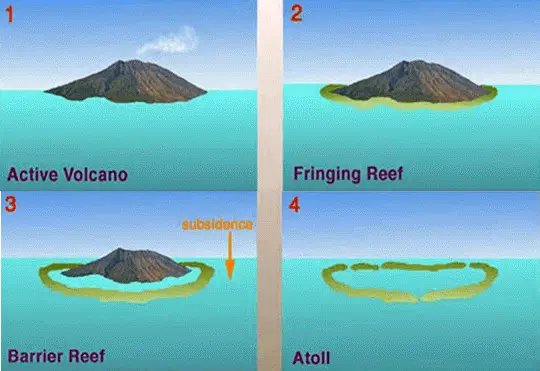
a) Fringing Reefs
- Fringing reefslie near emergent land. They are fairly shallow, narrow and recently formed.
- These are the most common types of reefs, project seaward directly from the shore, forming borders along the shoreline and surrounding islands.
- They can be separated from the coast by a navigable channel.
b) Barrier Reefs
- Barrier reefs are broader and lie farther away from the coast.
- They are separated from the coast by a stretch of water (lagoon) which can be up to several miles wide and several tens of metres deep.
- Sandy islands covered with a characteristic pattern of vegetation have sometimes formed on top of a barrier reef.
- The coastline of these islands is broken by passes, which have occupied the beds of former rivers.
c) Atoll
- Atollsare large, ring-shaped reefs lying off the coast, with a lagoon in their middle.
- Atolls develop near the sea surface on underwater islands or on islands that sink, or subside.
- The emergent part of the reef is often covered with accumulated sediments and the most characteristic vegetation growing on these reefs consists of coconut trees.
- In addition to being some of the most beautiful and biologically diverse habitats in the ocean, barrier reefs and atolls also are some of the oldest.
- It can take up to 10,000 years for a coral reef to form from a group of larvae.
Distribution of Coral Reefs
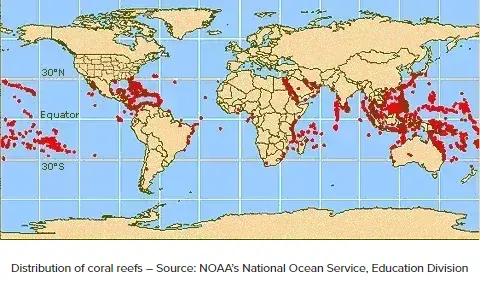
- Coral reefs are found throughout the oceans, from deep, cold waters to shallow, tropical waters.
- Temperate and tropical reefs however are formed only in a zone extending at most from 30°N to 30°S of the equator
- The reef-building corals prefer to grow at depths shallower than 30 m (100 ft), or where the temperature range is between 16-32oc, and light levels are high.
- Soft corals are found in oceans from the equator to the north and south poles, generally in caves or ledges.
- Here, they hang down in order to capture food floating by in the currents that are usually typical of these places.
Coral Triangle
|
Symbiotic Relationship
- Corals share a symbiotic relationship with single-celled photosynthetic algae called zooxanthellae.
- The coral provides the algae with a protected environment and compounds they need for photosynthesis.
- In return, the algae produce oxygen and help the coral to remove wastes.
- Most importantly, zooxanthellae supply the coral with glucose, glycerol, and amino acids, which are the products of photosynthesis. Infact, these algae are the coral’s primary food source.
- While most of a corals diet is obtained from zooxanthellae, they can also ‘fish’ for food too. During feeding a coral polyp will extend its tentacles out from its body and wave them in the water current where they encounter small fish, plankton or other food particles.
- Zooxanthellae are also responsible for the unique and beautiful colours of many stony corals.
- Because their algal cells need light for photosynthesis, reef corals require clear water. For this reason, they are generally found only in waters with small amounts of suspended material, i.e., in water of low turbidity and low productivity.
- This leads to an interesting paradox—coral reefs require clear, nutrient-poor water, but they are among the most productive and diverse marine environments.
Ideal conditions for the formation of coral reefs
- Reef-building corals cannot tolerate water temperatures below 18° Celsius.
- Many grow optimally in water temperatures between 23° and 29° C, but some can tolerate temperatures as high as 40° C for short periods.
- Most also require very saline (salty) water ranging from 32 to 42 parts per thousand, which must also be clear so that a maximum amount of light penetrates it.
- The corals’ requirement for high light also explains why most reef-building species are restricted to the euphotic zone, the region in the ocean where light penetrates to a depth of approximately 70 meters.
What is Coral Bleaching?
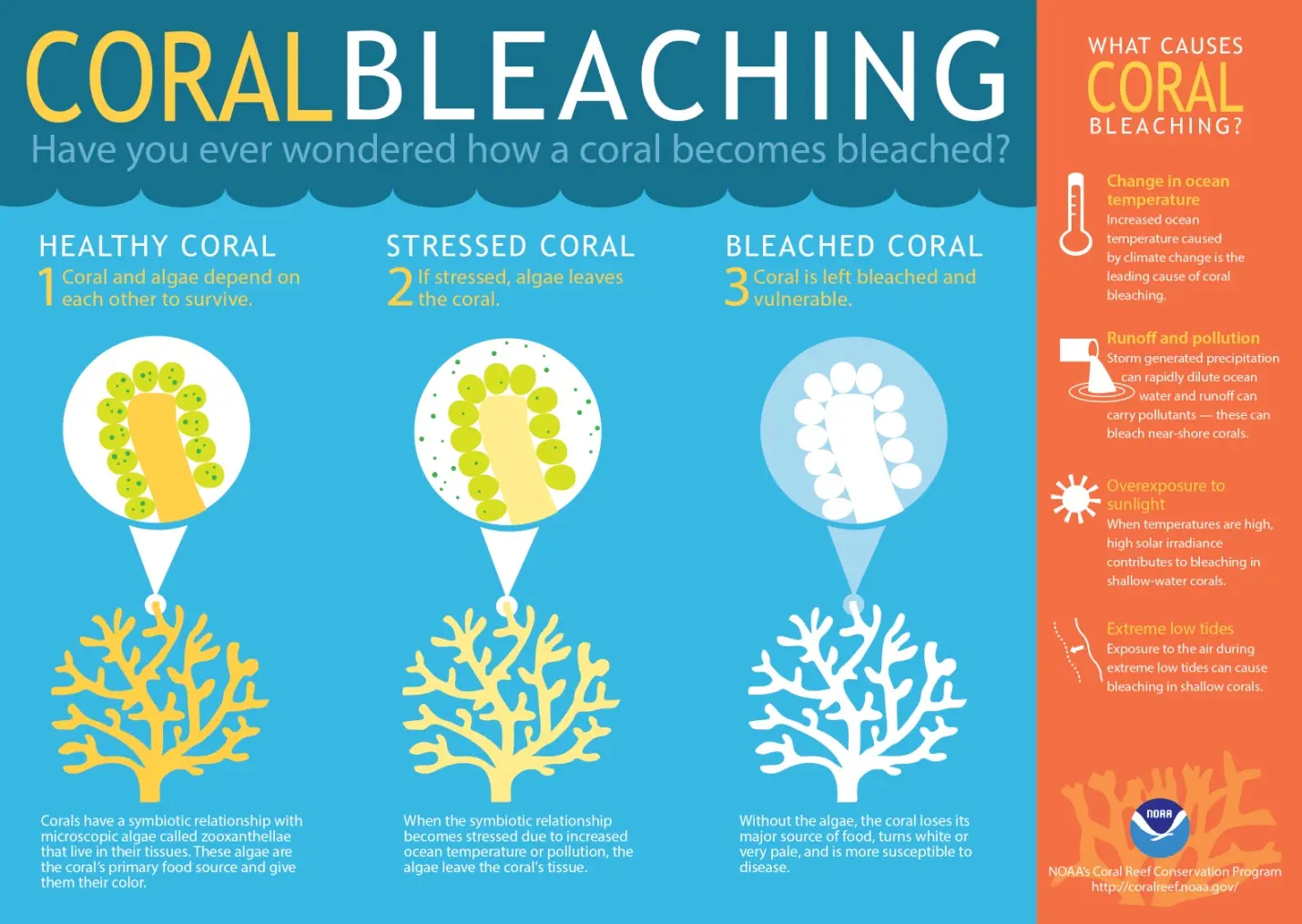
- Under stressed conditions, the zooxanthellae or food-producing algae living inside coral polyps start producing reactive oxygen species, which are not beneficial to the corals.
- So, the corals expel the colour-giving zooxanthellae from their polyps, which exposes their pale white exoskeleton, giving the corals a bleached appearance. This is called coral bleaching. This also ends the symbiotic relationship that helps the corals to survive and grow.
- Bleaching happens when corals experience stress in their environment due to changes in temperature, overexposure to sunlight, runoff pollution or high levels of ocean acidity.
- Increased ocean temperature caused by climate change is the leading cause of coral bleaching.
- Exposure to the air during extreme low tides can cause bleaching in shallow corals.
| • Major factors linked to coral bleaching include rising acidity associated with the increased absorption of carbon dioxide by the oceans, ultraviolet radiation exposure, drying from extreme low-tide events (such as those associated with El Niño), sedimentation, pollution, and disease. |
- When some pollutants enter the water, nutrient levels can increase, promoting the rapid growth of algae and other organisms that can smother corals.
- Petroleum spills do not always appear to affect corals directly because the oil usually stays near the surface of the water, and much of it evaporates into the atmosphere within days.
- However, if an oil spill occurs while corals are spawning, the eggs and sperm can be damaged as they float near the surface before they fertilize and settle.
- Bleached corals can survive depending on the levels of bleaching and the recovery of sea temperatures to normal levels.
- If heat-pollutions subside in time, over a few weeks, the zooxanthellae can come back to the corals and restart the partnership but severe bleaching and prolonged stress in the external environment can lead to coral death.
Why should We Protect Coral Reefs?
- Protecting coral reefs is crucial for several reasons:
- Biodiversity: Coral reefs are often called the rainforests of the sea because they support an incredibly diverse range of marine life. They provide habitats for numerous species of fish, invertebrates, and other marine organisms.
- Economic Importance: Coral reefs contribute significantly to the economy through fisheries, tourism, and coastal protection. Millions of people depend on coral reefs for their livelihoods, whether directly through fishing or indirectly through tourism.
- Coastal Protection: Coral reefs act as natural barriers that help protect coastlines from erosion and storm damage by reducing the power of waves hitting the shore.
- Climate Regulation: Coral reefs play a role in regulating the Earth’s climate by absorbing carbon dioxide from the atmosphere, which helps mitigate climate change.
- Medicinal Potential: Coral reefs are a potential source of new medicines and pharmaceuticals. Many organisms that live in coral reefs produce chemical compounds that could be used to develop new drugs.
How can We Protect Coral Reefs?
- To protect corals, several measures can be taken:
- Reduce Pollution: Pollution from land-based sources, such as agricultural runoff, sewage, and coastal development, can harm coral reefs. Implementing measures to reduce pollution and improve water quality can help protect coral reefs.
- Sustainable Fishing Practices: Overfishing can disrupt the balance of coral reef ecosystems. Implementing regulations and practices that promote sustainable fishing can help ensure that fish populations remain healthy and that the ecosystem remains in balance.
- Marine Protected Areas: Establishing marine protected areas (MPAs) where fishing and other human activities are restricted can help protect coral reefs and allow them to recover from damage.
- Climate Change Mitigation: Climate change is one of the greatest threats to coral reefs, primarily due to rising sea temperatures and ocean acidification. Taking action to reduce greenhouse gas emissions and mitigate climate change is essential for the long-term survival of coral reefs.
- Educational Outreach: Educating the public about the importance of coral reefs and the actions they can take to help protect them can raise awareness and promote conservation efforts.
- Coral Reef Restoration: In areas where coral reefs have been damaged, restoration efforts, such as coral transplantation and reef rehabilitation, can help restore coral populations and rebuild damaged reef ecosystems.
- By implementing these measures, we can help protect coral reefs and ensure that they continue to thrive for future generations.
Read also: Andaman and Nicobar (A&N) Islands : Location, History and Significance | UPSC
Major Initiatives Aimed at the Protection of Coral Reefs
- Coral reef protection and restoration is central to the UN Decade on Ecosystem Restoration (2021-2030) geared towards the restoration of degraded and destroyed ecosystems to enhance food security, clean our air quality, secure water supply, address the climate crisis and protect habitats that support life on earth as we know it.
- The UN Decade of Ocean Science for Sustainable Development (2021-2030) also puts a spotlight on coral reefs to inspire advances in science and technology to improve ocean health. Some other important initiatives are:
a) Glowing Glowing Gone Campaign
- It aims to inspire the policy and funding necessary to save coral reefs through a global show of support.
b) International Coral Reef Initiative (ICRI)
- It is an informal partnership between Nations and organizations which strives to preserve coral reefs and related ecosystems around the world. ICRI was launched at the United Nations Global Conference on Sustainable Development of Small Islands Developing States in Barbados in 1994.
- ICRI is a joint initiative of several countries in partnership with other coral reef nations around the world, non-governmental organizations (NGOs), international organizations, multilateral development banks, and private sector businesses.
c) Coral Reef Breakthrough
- It aims to secure the future of at least 125,000 km2 of shallow-water tropical coral reefs with investments of at least US$12 billion to support the resilience of more than half a billion people globally by 2030.
Distribution of coral reefs in India
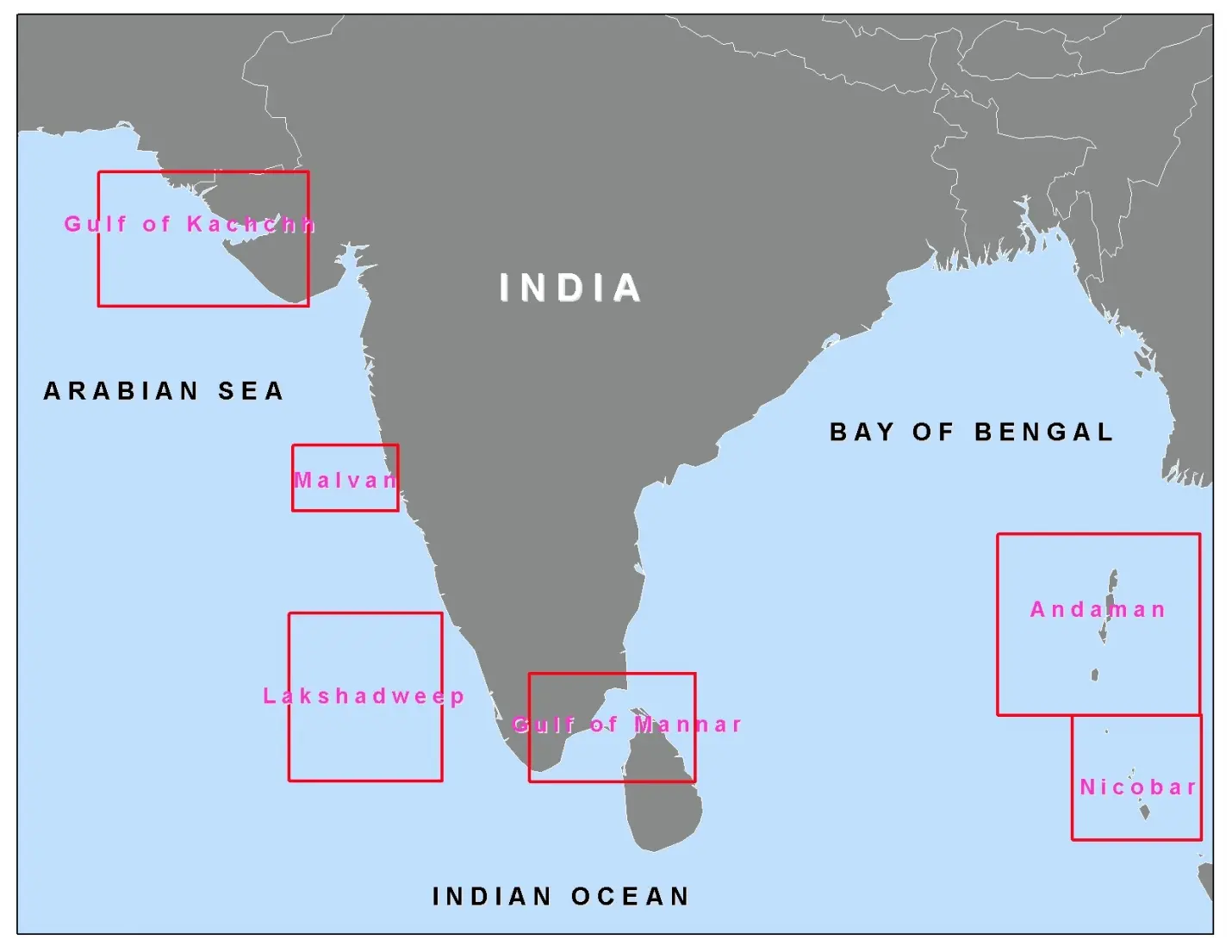
- Coral reefs are present in the areas of Gulf of Kutch, Gulf of Mannar, Andaman & Nicobar, Lakshadweep Islands and Malvan.
- All coral species are protected under Schedule-I of the Indian Wildlife Protection Act (1972).
Conclusion
- Coral reefs are remarkable ecosystems that support a wealth of marine life and provide numerous benefits to humans. However, they are under increasing threat from climate change, pollution, overfishing, and other human activities.
- It is imperative that we take action to mitigate these threats and protect coral reefs for future generations to enjoy and benefit from their invaluable services. Conservation efforts, sustainable management practices, and global cooperation are crucial for the preservation of these fragile and irreplaceable ecosystems.
References:
- https://oceanservice.noaa.gov/facts/coral.html
- https://icriforum.org/about-coral-reefs/what-are-corals/
- https://oceanservice.noaa.gov/facts/coral_bleach.html
- https://coralreef.noaa.gov/education/coralfacts.html#:~:text=Hard%20corals%20that%20form%20reefs,present%20in%20a%20reef%20ecosystems.
- https://incois.gov.in/portal/CoralReef.jsp

